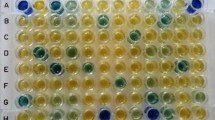The production of rhodotorulic acid, a siderophore synthesized by Rhodotorula strains, was improved with the objective of achieving the biocontrol of phytopathogenic moulds. Rhodotorulic acid increased up to 60% in the presence of urea as a nitrogen source, pH near to 8 and a C:N ratio of 8:1. The siderophore-containing spent medium showed in vitro antifungal activity against important plant pathogens including Botrytis cinerea, which causes grey mould on a wide variety of host plants including numerous commercial crops. The antifungal activity was related to siderophore concentration. Journal of Industrial Microbiology & Biotechnology (2001) 26, 226–229.
Similar content being viewed by others
Author information
Authors and Affiliations
Additional information
Received 06 June 2000/ Accepted in revised form 28 January 2001
Rights and permissions
About this article
Cite this article
Calvente, V., de Orellano, M., Sansone, G. et al. Effect of nitrogen source and pH on siderophore production by Rhodotorula strains and their application to biocontrol of phytopathogenic moulds. J Ind Microbiol Biotech 26, 226–229 (2001). https://doi.org/10.1038/sj.jim.7000117
Issue Date:
DOI: https://doi.org/10.1038/sj.jim.7000117




